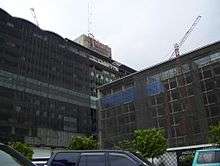Hotel Indonesia
| Hotel Indonesia Kempinski Jakarta | |
|---|---|
|
Bundaran HI ("Hotel Indonesia Roundabout") with Hotel Indonesia on the right | |
| Hotel chain | Kempinski Hotels |
| General information | |
| Location | Jakarta, Indonesia |
| Coordinates | 6°11′44″S 106°49′19″E / 6.19556°S 106.82194°E |
| Opening | 5 August 1962 |
| Management | Sjefke Jansen (General Manager) |
| Design and construction | |
| Architect | Abel Sorensen |
| Other information | |
| Number of rooms | 289 |
| Number of suites | 11 |
| Number of restaurants | 4 |
| Number of bars | 2 |
| Facilities | Roof top Spa with Gym & Swimming Pool |
| Website | |
| www.kempinski.com/jakarta | |
Hotel Indonesia Kempinski Jakarta, commonly abbreviated as HI, is one of the oldest and best known hotels in Jakarta, Indonesia. Located in Central Jakarta, it is one of the first 5-star hotels in South-East Asia and remains a major landmark of Jakarta. Its fame is often linked to the Indonesia's political pride. It is located by the famed Hotel Indonesia Roundabout, which gets its name from the hotel and neighbors with Grand Indonesia and Plaza Indonesia shopping malls.[1]
Occupying 25,082 m2 (269,980 sq ft) of land, Hotel Indonesia was designed by a Danish architect, Abel Sorensen, and his wife, Wendy Becker. The hotel was inaugurated on August 5, 1962 by Indonesia's first President, Sukarno in preparation for the 1962 Asian Games. The building was declared as national heritage by the local government, Pemda DKI, on 29 March 1993.[2][3]
In 2004, the hotel underwent a complete renovation, which was completed in 2009, reopening as the Hotel Indonesia Kempinski, managed by Europe’s oldest luxury hotel group, Kempinski Hotels.
History
- 1962
Soekarno appointed architect Abel Sorensen and his wife Wendy to design the hotel to showcase a modern Indonesia[4]. Hotel Indonesia first operated in 1962, inaugurated by the first President Sukarno as the first five star hotel in Southeast Asia to offer international standards. In front of the hotel, located in the heart of the capital, stands the “Welcome Monument”, intended to welcome the guests who were visiting Jakarta for the 4th Asian Games in 1962. Following the games, the hotel was used by President Sukarno to host state guests, and also official events.
- 1960s-70s
During its heyday, Hotel Indonesia was the center of many cultural activities. Musical and theatrical performances were routinely staged at the hotel, serving as a launch pad for several renowned Indonesian artists to stardom, notably, among others, Teguh Karya who was the hotel’s stage manager, Slamet Rahardjo and Rima Melati. In 1969 Hotel Indonesia hosted Miss Indonesia pageant, won by Irma Hadisurya. By the 1970s, the Nirwana Supper Club on the highest terrace of the Ramayana Wing was the venue of choice for Jakarta elites to enjoy a fancy dinner, complete with live entertainment by popular musician, local and international.
- 1993
Hotel Indonesia was designated as a cultural heritage site by the Decree of the Governor of Jakarta No. 475 dated 29 March 1993. The decree commanded that the building and all of its historical assets should be well preserved and maintained.[5]
- 2004–present
In 2004, the government decided to completely renovate the hotel, and HI stopped operating that year. After the renovation was completed, the Hotel Indonesia became the Hotel Indonesia Kempinski on 20 May 2009, managed by Kempinski Hotels SA, the oldest luxury hotel group in Europe.

Facilities
The hotel had 406 guestrooms originally which was reduced to 289 during renovation, consists of two wings, the Ramayana Wing and Ganesha Wing including Presidential Suite and four Diplomatic Suites. There are eight floors of the Ganesha Wing and 16 floors of the Ramayana Wing [6]. Ramayana Wing featured two types of guest rooms: Deluxe room (44 square metres) and Grand Deluxe room with range size of 58-62 square meters with total of 129 rooms. Ganesha Wing, a wing designed for premium business travelers operates a total of 160 rooms consists of 1 super secured and bullet proof Presidential Suite, 4 Diplomatic Suites, 6 Salon Suites, 90 Executive Grand Deluxe, and 59 Deluxe room complemented by a Lounge at the 7th floor.
The hotel originally boasted a large Olympic-size swimming pool in its backyard. But after the renovation in 2004, it was replaced by smaller swimming pool on the roof terrace. The Grand Indonesia shopping mall now stands on the site of the original pool. The 3,000-square meters Kempinski Grand Ballroom, opened in March 2008, has held various corporate activities, exhibition wedding and events. The historical oval shaped 1,000-square meters Bali Room, has been operated since September 2008.[7]
External links
- Kempinski Hotels
- (in Indonesian) Saksi Bisu Penyimpan Sejarah dan Kenangan Bangsa
- (in Indonesian) Jangan Biarkan HI Tinggal Kenangan
References
- ↑ "A Luxury Heritage in the Heart of Jakarta". Retrieved 8 August 2018.
- ↑ Keputusan Gunbernur Kapala Daerah Khusus Ibukota Jakarta, No 475, 1993, tentang Penetapan Bangunan-bangunan Bersejarah di Daerah Khusus Ibukota Jakarta Sebagai Benda Cagar Budaya, 29 March 1993 [Decision of the Regional Head of the Special Area of the Capital City of Jakarta, No 475, 1993, about Declaration of Historic Buildings in the Special Area of the Capital City of Jakarta as Heritage Items, 29 March 1993].
- ↑ "Five things to know about the historical Hotel Indonesia". The Jakarta Post. Retrieved 8 August 2018.
- ↑ "Five things to know about the historical Hotel Indonesia". The Jakarta Post. Retrieved 8 August 2018.
- ↑ Ibid.
- ↑ "Sepotong Sejarah Hotel Indonesia, Dibangun Karena Asian Games". Kompas. Retrieved 8 August 2018.
- ↑ "A Luxury Heritage in the Heart of Jakarta". Retrieved 8 August 2018.